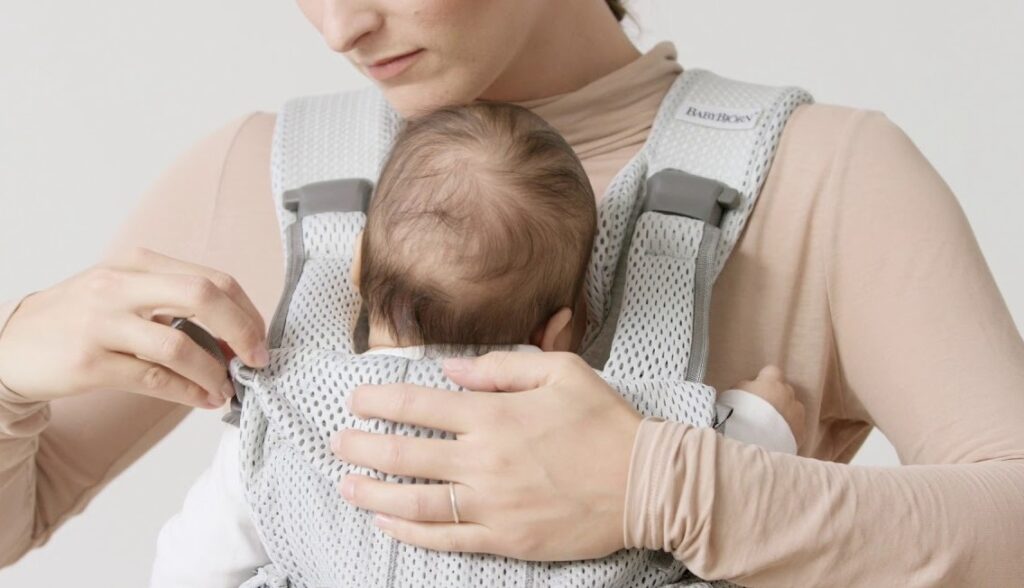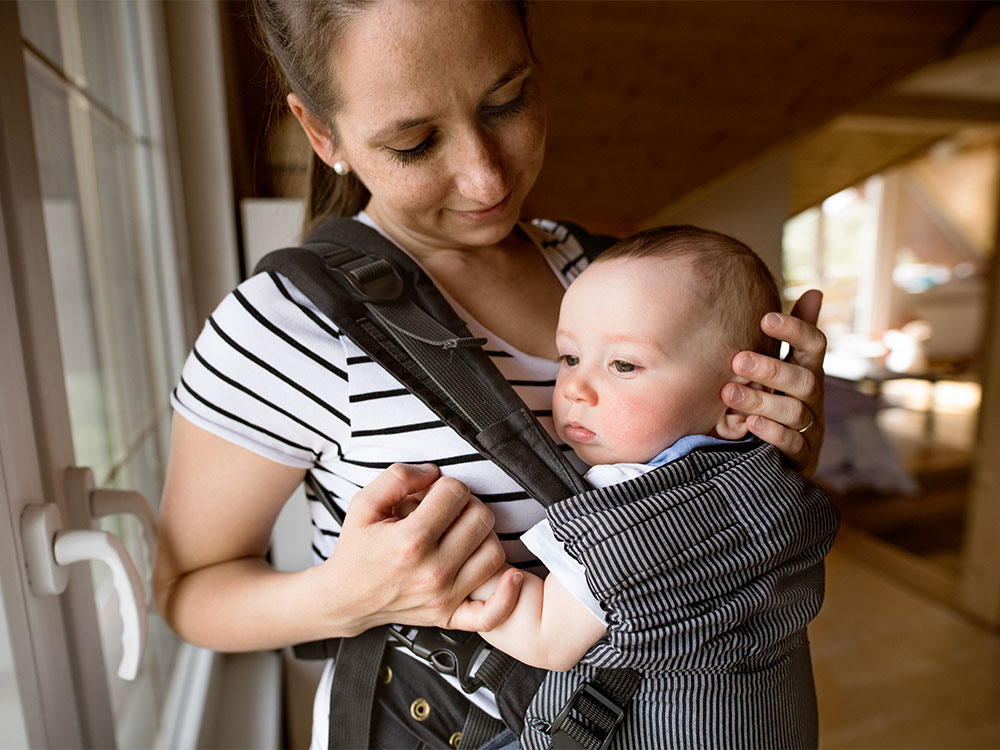Parents cherish the warmth and closeness of holding their newborns, finding comfort in the gentle rise and fall of each tiny breath. The need to stay connected while managing daily tasks often leads to solutions that offer both security and convenience. But also, let’s face it -moms cannot do anything around the house with their little ones constantly in their arms.
They really need to turn to a hands-free approach that allows them to keep their little ones snug while navigating chores, errands, or simple moments of rest.
Many new parents rely on baby carriers to keep their little ones close while freeing up their hands. Some wear their infants throughout the day, leading to one big question: how long is too long?
Key Points
- Proper positioning is essential to avoid strain on the baby’s body and ensure long-term comfort.
- Prolonged wear can lead to overheating and pressure points, which may cause discomfort.
- Regular breaks help improve circulation and allow for natural movement.
- Infants have different needs at various growth stages, so carrier use should be adjusted accordingly.
- Always choose an ergonomic design that supports the baby’s posture and overall well-being.
Posture and Positioning Matter

Maintaining proper posture is crucial when carrying an infant for extended periods. A poorly designed carrier or incorrect positioning can lead to issues such as hip dysplasia or back strain. Ensuring the right alignment helps promote healthy spinal and hip development.
Things to Check
- Knees higher than the hips (M-shape position): This position distributes weight evenly and supports natural hip development.
- Back well-supported without curving too much: A straight but slightly rounded spine mimics the natural fetal position and prevents discomfort.
- Head positioned for clear airways: Keeping the chin slightly lifted ensures the baby can breathe easily without obstruction.
Ergonomic models offer better support for longer periods. Avoid carriers that force legs into a straight position or cause unnatural spine bending.
Circulation and Breathing Considerations
Babies have delicate airways and require enough space to breathe comfortably. If their chin is pressed too close to their chest, breathing may become restricted, which can lead to oxygen deprivation. Blood circulation must also remain unimpeded to prevent numbness or discomfort.
To Prevent Restricted Blood Flow and Breathing Issues:
- Shift positions regularly: Adjusting the baby’s placement reduces pressure on any one area and improves circulation.
- Ensure even weight distribution: A well-fitted carrier evenly distributes weight, reducing strain on specific parts of the baby’s body.
- Watch for signs of discomfort: If the baby seems restless or fussy, check for any positioning issues or constriction.
Overheating Can Be a Concern

Body heat can build up quickly in an enclosed carrier, especially in warm environments. Overheating can make the baby irritable and uncomfortable, leading to excessive sweating and even heat exhaustion in extreme cases.
Prevent Heat Buildup
- Dress lightly in warm weather: Choose breathable cotton outfits to avoid trapping heat.
- Use a carrier with good ventilation: Mesh panels or light fabrics help regulate body temperature.
- Monitor for sweating or flushed skin: Signs of overheating include damp hair, red cheeks, or restlessness. If you notice these signs, remove the baby from the carrier and cool them down immediately.
Effects on Hip and Spine Development
Proper hip and spine alignment is crucial for healthy musculoskeletal development. In the first few months, the hip joints are still forming, making them vulnerable to misalignment if not properly supported.
Important Factors to Consider:
- Newborns require extra support: The natural C-curve of their spine should be maintained, avoiding stiff carriers that force an unnatural straight posture.
- Hip placement is key: Legs should be spread in a frog-like stance rather than dangling straight down, reducing the risk of hip dysplasia.
- Choose adjustable carriers: As the baby grows, the carrier should accommodate different weight distributions and postures.
Attention to Feeding and Hydration
Keeping the baby in the same position for too long can interfere with digestion and hydration. This is especially important for breastfeeding or formula-fed infants who need frequent feeds.
Helpful Adjustments
- Shift positions during feeds: Changing angles can help with digestion and reduce gas buildup.
- Allow time for burping: Keeping the baby upright after feeding prevents discomfort and reduces the risk of reflux.
- Give breaks for hydration and movement: Babies may not always signal thirst, so ensure they have regular opportunities to nurse or bottle-feed outside the carrier.
Psychological and Bonding Aspects
Close contact strengthens the parent-child bond, offering warmth, security, and emotional connection. However, constantly carrying the baby may limit independent movement and exploration, which are essential for cognitive and motor development.
Balance Is Key:
- Alternate between babywearing and other activities: Floor play and tummy time encourage muscle development and independence.
- Provide space for free movement: Allow the baby to stretch, kick, and roll outside of the carrier.
- Offer different ways to explore surroundings: Let the baby engage with toys, interact with others, and experience varied sensory input beyond close contact.
Signs That a Break Is Needed
Babies communicate discomfort in subtle ways. Ignoring these cues may lead to irritation or restlessness.
Watch for Signals Indicating Discomfort:
- Fussiness or restlessness: The baby may squirm or cry when uncomfortable.
- Red marks on skin: Pressure points from straps or fabric folds can cause temporary marks, indicating a need for repositioning.
- Excessive sweating: Signs of overheating should be addressed promptly to avoid discomfort.
- Stiff or awkward positioning: The baby should always appear relaxed, not tense or rigid.
Frequent breaks reduce strain and allow for proper circulation. Shifting positions keeps muscles active and prevents soreness.
When to Limit Time in a Carrier
The baby’s needs change with age, and some infants may require shorter wearing periods. Special attention is needed for premature or medically fragile infants.
Consider Limiting Carrier Use If:
- The baby was born prematurely or has low birth weight: Extra care is required to ensure sufficient breathing space and body support.
- The infant has reflux or breathing concerns: Some conditions require upright positioning or frequent adjustments.
- Discomfort appears after short durations: Persistent fussiness after short periods in the carrier may signal discomfort or improper positioning.
Older infants may tolerate longer wear but still need variation in movement and positioning.
Expert-Backed Guidelines for Extended Use

Health professionals recommend balancing carrier use with other activities to promote healthy growth and well-being.
Tips for Longer Periods
- Use a well-designed, ergonomic carrier. A good carrier distributes weight evenly and provides proper support.
- Maintain proper positioning for spine and hips. Regular checks ensure optimal alignment and prevent issues.
- Take breaks for movement and stretching. Shifting positions regularly reduces pressure points and improves circulation.
- Monitor temperature to avoid overheating. Dress appropriately for the climate and ensure good airflow.
- Stay attentive to the baby’s cues and comfort. Recognizing signs of discomfort ensures a more pleasant experience for both the parent and baby.
Conclusion
Carrying your little one for long durations can be comfortable and beneficial when done correctly. Pay attention to positioning, circulation, and temperature to ensure a cozy and secure experience. Breaks and movement shifts keep your child comfortable, supported, and happy.







